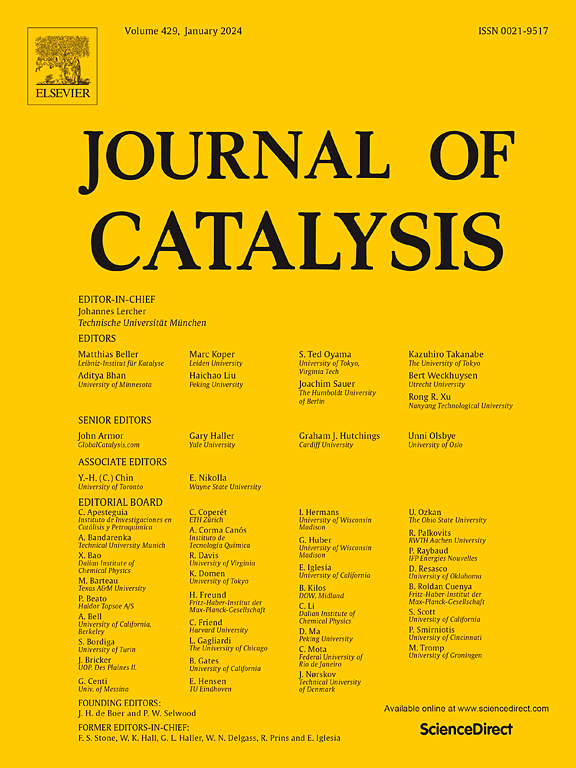Zn modulating the metal support interaction to promote the sintering resistance of hydrotalcite-derived NiZnAl catalyst for methane cracking
IF 6.5
1区 化学
Q2 CHEMISTRY, PHYSICAL
引用次数: 0
Abstract
Developing an efficient and environmentally friendly catalyst is important for the production of pure H2 and carbon nanomaterials. Catalytic cracking of methane offers the possibility of producing these high-value products. For this reason, stabilizing the surface active sites of activated methane by modulating the interaction between metal and support has attracted much attention in the development of hydrotalcite-derived NiAl catalysts. Hence, the influence of Zn content and cracking temperature on the structure and performance of hydrotalcite-derived NiZnAl methane cracking catalysts were investigated. It is shown that alloying Zn with Ni reduces the electron density near Ni atoms, promotes the reduction of mixed metal oxides, producing strong interactions between Ni and support, thus improving the stability of the catalyst during methane decomposition. Thus, this strong interaction between Ni and support stabilized the Ni particle size and inhibited the sintering of Ni during the reaction. The Ni2.7Zn0.3Al can maintain a H2 yield of more than 60 % over a 600 min reaction time at 600 °C. TEM analysis showed that the strong metal support interaction changed the morphology of the deposited carbon, maintained the balance between carbon diffusion and CH4 dissociation, provided more growth sites for carbon nanotubes, and also prevented the rapid deactivation of the catalysts because of carbon encapsulation. This article may provide guidance for the design of Ni-based methane cracking catalysts with excellent stability.


锌调节金属载体相互作用以提高水滑石衍生NiZnAl甲烷裂化催化剂的烧结性能
开发高效、环保的催化剂对于制备纯氢和纯碳纳米材料具有重要意义。甲烷的催化裂化为生产这些高价值产品提供了可能。因此,通过调节金属与载体之间的相互作用来稳定活性甲烷的表面活性位点一直是水滑石衍生NiAl催化剂的研究热点。因此,研究了锌含量和裂解温度对水滑石衍生的NiZnAl甲烷裂解催化剂结构和性能的影响。结果表明,Zn与Ni的合金化降低了Ni原子附近的电子密度,促进了混合金属氧化物的还原,使Ni与载体之间产生强相互作用,从而提高了催化剂在甲烷分解过程中的稳定性。因此,Ni与载体之间的强相互作用稳定了Ni的粒径,抑制了Ni在反应过程中的烧结。在600 ℃下,反应时间600 min, Ni2.7Zn0.3Al的H2产率保持在60 %以上。TEM分析表明,强的金属载体相互作用改变了沉积碳的形态,维持了碳扩散和CH4解离之间的平衡,为碳纳米管提供了更多的生长位点,也防止了催化剂因碳包封而快速失活。本文可为设计稳定性优良的镍基甲烷裂化催化剂提供指导。
本文章由计算机程序翻译,如有差异,请以英文原文为准。
求助全文
约1分钟内获得全文
求助全文
来源期刊

Journal of Catalysis
工程技术-工程:化工
CiteScore
12.30
自引率
5.50%
发文量
447
审稿时长
31 days
期刊介绍:
The Journal of Catalysis publishes scholarly articles on both heterogeneous and homogeneous catalysis, covering a wide range of chemical transformations. These include various types of catalysis, such as those mediated by photons, plasmons, and electrons. The focus of the studies is to understand the relationship between catalytic function and the underlying chemical properties of surfaces and metal complexes.
The articles in the journal offer innovative concepts and explore the synthesis and kinetics of inorganic solids and homogeneous complexes. Furthermore, they discuss spectroscopic techniques for characterizing catalysts, investigate the interaction of probes and reacting species with catalysts, and employ theoretical methods.
The research presented in the journal should have direct relevance to the field of catalytic processes, addressing either fundamental aspects or applications of catalysis.
 求助内容:
求助内容: 应助结果提醒方式:
应助结果提醒方式:


